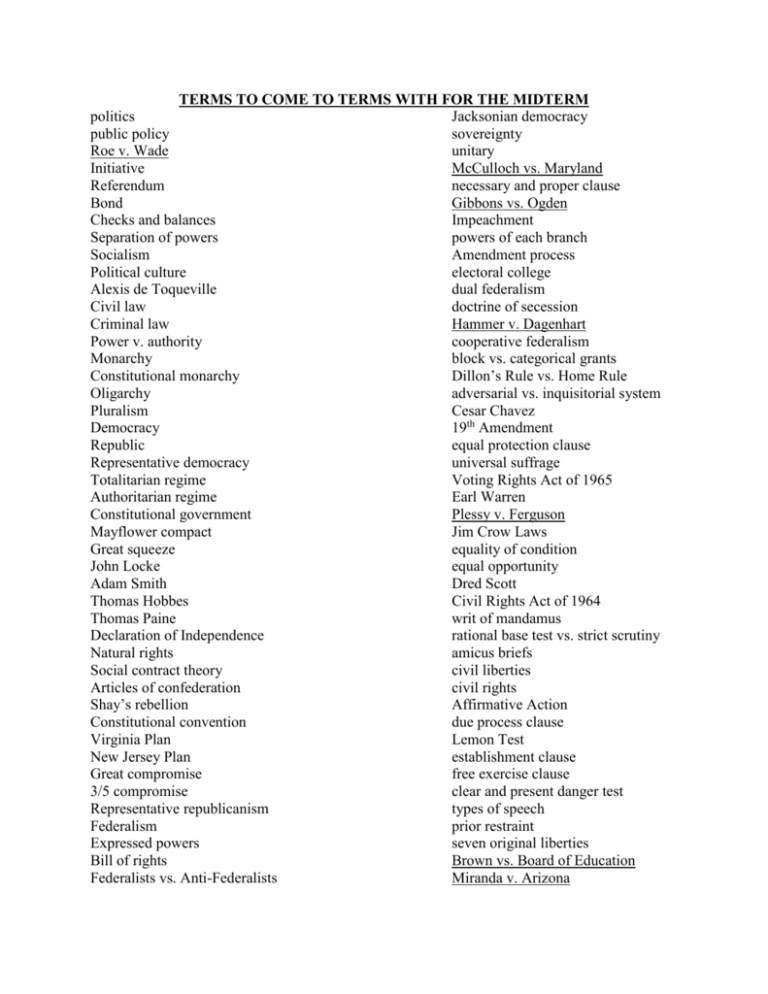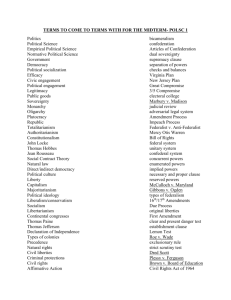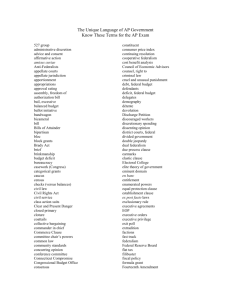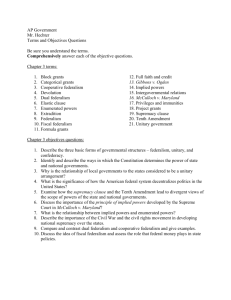TERMS TO COME TO TERMS WITH FOR THE MIDTERM politics
advertisement

TERMS TO COME TO TERMS WITH FOR THE MIDTERM politics Jacksonian democracy public policy sovereignty Roe v. Wade unitary Initiative McCulloch vs. Maryland Referendum necessary and proper clause Bond Gibbons vs. Ogden Checks and balances Impeachment Separation of powers powers of each branch Socialism Amendment process Political culture electoral college Alexis de Toqueville dual federalism Civil law doctrine of secession Criminal law Hammer v. Dagenhart Power v. authority cooperative federalism Monarchy block vs. categorical grants Constitutional monarchy Dillon’s Rule vs. Home Rule Oligarchy adversarial vs. inquisitorial system Pluralism Cesar Chavez Democracy 19th Amendment Republic equal protection clause Representative democracy universal suffrage Totalitarian regime Voting Rights Act of 1965 Authoritarian regime Earl Warren Constitutional government Plessy v. Ferguson Mayflower compact Jim Crow Laws Great squeeze equality of condition John Locke equal opportunity Adam Smith Dred Scott Thomas Hobbes Civil Rights Act of 1964 Thomas Paine writ of mandamus Declaration of Independence rational base test vs. strict scrutiny Natural rights amicus briefs Social contract theory civil liberties Articles of confederation civil rights Shay’s rebellion Affirmative Action Constitutional convention due process clause Virginia Plan Lemon Test New Jersey Plan establishment clause Great compromise free exercise clause 3/5 compromise clear and present danger test Representative republicanism types of speech Federalism prior restraint Expressed powers seven original liberties Bill of rights Brown vs. Board of Education Federalists vs. Anti-Federalists Miranda v. Arizona STUDY QUESTIONS FOR THE MIDTERM 1. Describe three types of participation in the U.S. 2. Describe three distinguishing features of a democracy. 3. Describe one aspect of democratic government that is unique to the United States. 4. Explain two basic features of the U.S. Constitution. 5. What is a public policy? Give two examples. 6. What is one weakness of a democracy? 7. What did the case Roe vs. Wade entail and what precedence did it set? 8. Describe one main difference between socialism and capitalism. 9. Explain the difference between government and politics. 10. What is the difference between a monarchy, an oligarchy, and a republic? 11. Explain the notion of pluralism. 12. What is the difference between an authoritarian regime and a totalitarian regime? 13. What was the “great squeeze” and how did it impact the colonies? 14. Who was Thomas Paine? What did he write? What did he argue in these pamphlets? 15. What were three complaints in the Declaration of Independence and how were these rectified in the Bill of Rights? 16. Explain the difference between natural rights, civil liberties, and civil rights. 17. What were the Articles of Confederation and why did they fail? 18. What was Shay’s Rebellion? 19. What was the Virginia Plan, the New Jersey Plan, and the Great Compromise? Explain the 3/5ths compromise. 20. Describe three core principles of the U.S. Constitution. 21. Explain the argument for and against the ratification of the U.S. Constitution. 22. Explain the difference between expressed powers and police powers. 23. What are two ways to amend the constitution? 24. Explain the process of impeachment. 25. What was the Framers purpose in creating the electoral college? How does it work? 26. How has federalism in the U.S. evolved? 27. Explain the advantages and disadvantages of federalism. 28. Explain the difference between a federal system, a unitary system, and a confederal system. Give an example of each. 29. What did the case McCulloch v. Maryland entail and what precedence did it set? 30. What did the case Gibbons v. Ogden entail and what precedence did it set? 31. Explain the difference between the supremacy clause, and the necessary and proper clause. 32. What is separation of powers? What are three powers of each branch? 33. What are checks and balance? Give an example of how each branch can check the other. How can states check the central government? 34. What did the case Hammer v. Dagenhart entail and what precedence did it set? 35. Explain the difference between a categorical and block grant. 36. Explain the difference between Dillon’s Rule and Home and Rule. 37. Explain how the court systems are organized. 38. Explain the difference between an adversarial system and an inquisitorial system. 39. Explain the idea of Equal Protection. 40. Explain Affirmative Action. 41. What did the case Brown v. Board of Education entail and what precedence did it set? 42. Explain the difference between a strict scrutiny and rational based test. 43. What are the seven original liberties? Define the Latin terms. 44. Describe three weaknesses of the courts in the U.S. What is one idea of reform? 45. What did the case Baron v. Baltimore entail and what precedence did it set? 46. What are five of your criminal rights in the Bill of Rights? 47. What are five of your civil liberties in the Bill of Rights 48. What are three types of speech protective by the First Amendment? What is speech not protected? 49. What is the establishment clause? 50. What is meant by the wall of separation? 51. What did the case Miranda v. Arizona entail and what precedence did it set? 52. What did the case Plessy v. Ferguson entail and what precedence did it set? 53. What is the equal protection clause? 54. Explain the Voting Rights Act of 1965. 55. Explain the Civil Rights Act of 1964.









